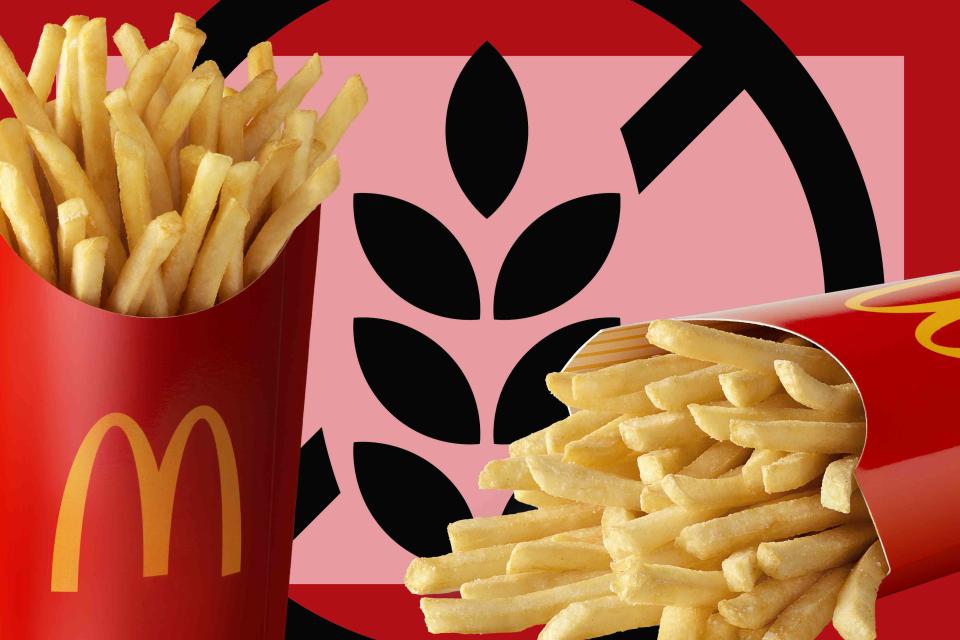This Ingredient Is Why McDonald’s French Fries Aren’t Gluten-Free
Here’s what you need to know — plus where to find gluten-free French fries.

Food & Wine / McDonald's
At their most basic, homemade French fries contain potatoes, oil, and salt — all gluten-free ingredients. So does that mean your drive-through French fries are gluten-free? Unfortunately, not always. McDonald’s confirmed in a statement to Food & Wine that its “World Famous Fries” are not gluten-free.
On its website, McDonald’s says its fries contain potatoes, vegetable oil, dextrose, a food additive to “maintain color” in the finished fries, and another additive listed as “Natural Beef Flavor.” That ingredient comes with an asterisk noting that the flavoring contains both hydrolyzed milk and hydrolyzed wheat. (And both milk and wheat are listed under the Allergen Information heading.)
According to the McDonald’s website, the fast food giant “currently doesn’t certify any menu items as gluten-free” at its restaurants in the United States. Although McDonald’s serves a few items that do not contain gluten — according to Celiac.com, its soft-serve ice cream (without a cone), salads, and coffee drinks are likely gluten-free — the chain still notes that, due to shared cooking and meal-prep areas, there is the potential for cross-contamination with foods and ingredients that do contain gluten.
What does gluten-free mean?
First, let’s talk about what gluten is: the Celiac Disease Foundation defines it as the “general name” for the proteins that are found in a variety of grains, including barley, rye, triticale, and wheat. Gluten is found in a tremendous number of products, even some unexpected ones, due to its use as a binding agent to hold foods together. It can also be added to foods to provide texture or flavor.
In order for a product to be labeled as “gluten-free,” the U.S. Food and Drug Administration (FDA) says that it must meet a number of criteria:
It must be “inherently gluten-free,” like fresh fruits or vegetables.
If it’s not naturally gluten-free, then it cannot contain any ingredients that are gluten-containing grains or are derived from gluten-containing grains “that [have] not been processed to remove gluten.”
If any gluten-containing grains have been processed to remove the gluten, then that ingredient must not contain any lingering gluten at a concentration higher than 20 parts per million.
Why can’t some people eat gluten?
The two most common reasons why someone may follow a gluten-free diet, or try to avoid gluten, are celiac disease or a gluten intolerance. Celiac disease is an inflammatory autoimmune disorder and, for those who live with this condition, eating gluten triggers an immune response which can damage the lining of the small intestine. According to the Cleveland Clinic, gluten intolerance, also called “non-celiac gluten sensitivity,” can cause someone to experience a variety of symptoms after eating gluten, including abdominal pain, nausea, diarrhea, or constipation.
Celiac disease and gluten intolerance are two separate conditions; the Cleveland Clinic says that the former affects around 1% of the U.S. population, while the latter may be present in 6% of the population.
What is hydrolyzed wheat protein?
According to a paper published in the journal Biomolecules, hydrolyzed wheat proteins are used in a number of foods — and even in some cosmetics — because they can be used as emulsifiers that help combine other ingredients, or because of their “foaming properties.” They are also used as flavor enhancers to enhance umami flavors, as in the “Natural Beef Flavor” found in McDonald’s fries.
Note that there’s some debate over whether hydrolyzed wheat protein is or isn’t gluten-free. In 2020 the FDA ruled that manufacturers must hold records confirming foods are gluten-free before hydrolysis.
Do all McDonald’s locations use hydrolyzed wheat protein?
In the U.S., it would appear so. In a statement to Food & Wine, a McDonald’s spokesperson wrote, “On background, we can confirm McDonald's World Famous Fries are not certified gluten-free.”
Outside of the U.S., this may not be the case. On the website for McDonald’s UK, the chain lists its French fries among its menu items that are gluten-free. It also publishes a frequently updated Allergen Booklet that lists which common allergens may be present in its current menu items.
Where can you find gluten-free French fries?
Celiac.com has a detailed list of restaurant French fries that are gluten-free. These include Five Guys and In-N-Out-Burger. Still, if you have a gluten allergy, you should always mention it to the staff to avoid any cross-contamination.
For more Food & Wine news, make sure to sign up for our newsletter!
Read the original article on Food & Wine.

 Yahoo Lifestyle
Yahoo Lifestyle 
